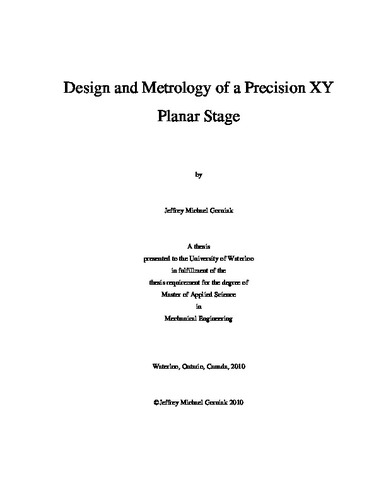| dc.description.abstract | In recent years, the manufacturing industry has seen an increase in demand for micro-components in biomedical, opto-mechatronics, and automotive applications. Traditional machine tools are no longer a viable solution to meet the tolerances required by the customers. Hence, new ultra-precision machine tools have emerged with nanometer level accuracy in response to these demands. This thesis presents a novel ultra-precision machine tool with the intent to bridge the gap between traditional machine tools with larger work volumes and lower accuracy, and ultra-precision machine tools with high accuracy and small work volumes. The machine was designed using a T-type gantry and worktable configuration with a precision ground granite base, to achieve a work area of 300x300 mm2, with a maximum velocity of 1 m/s and a maximum acceleration of 10 m/s2. Actuation is provided by direct drive linear motors with high resolution feedback supplied by 4 µm grating linear encoders with 4096x interpolation. Aerostatic porous bearings are employed to reduce the effect of friction while maintain high stiffness of the guideways and structure. A Vacuum Pre-Loaded (VPL) air bearing supports the worktable on the granite, decoupling vertical load from the gantry. Thermal error reduction is achieved using environmental temperature control (20 ± 0.2°C) to help reduce thermal errors. As well, internally cooled couplings were designed to remove heat generated by the motors, thus further reducing the effects that contribute to thermal error.
The target static stiffness of the machine was 50 N/µm and was measured to be 22.2 N/µm and 23.9 N/µm in the x and y axes respectively. Frequency response experiments were used to identify the open-loop transfer functions for each axis. A multivariable framework was implemented for the y-axis due to the cross coupling between the primary and secondary motors of the gantry. Two prominent vibration modes were identified at 68 Hz and 344 Hz. The first mode is attributed to the rigid body yaw mode of the gantry while the higher frequency is related to the bending mode of the beam. The first mode of the x-axis is seen at 220 Hz. A state space, active mode compensation control law was developed for the y-axis, in collaboration with Mr. Daniel Gordon, which eliminates the effects of the 68 Hz mode, allowing for high performance from the motors. The following error during a high speed (200 mm/s) test was measured at 2.74 µm and 2.41 µm in the x and y axes respectively.
Metrology tests using laser interferometry were performed in accordance with international and American metrology standards for linear positioning, vertical and horizontal straightness, and yaw and pitch errors. The results will be used for geometric error compensation in future work. Finally, an overall error budget is presented with focus on the geometric, dynamic, servo, and thermal errors, where the maximum static resultant error of the machine was estimated to be 1.44 µm, and the maximum dynamic resultant error of 3.69 µm. | en |

